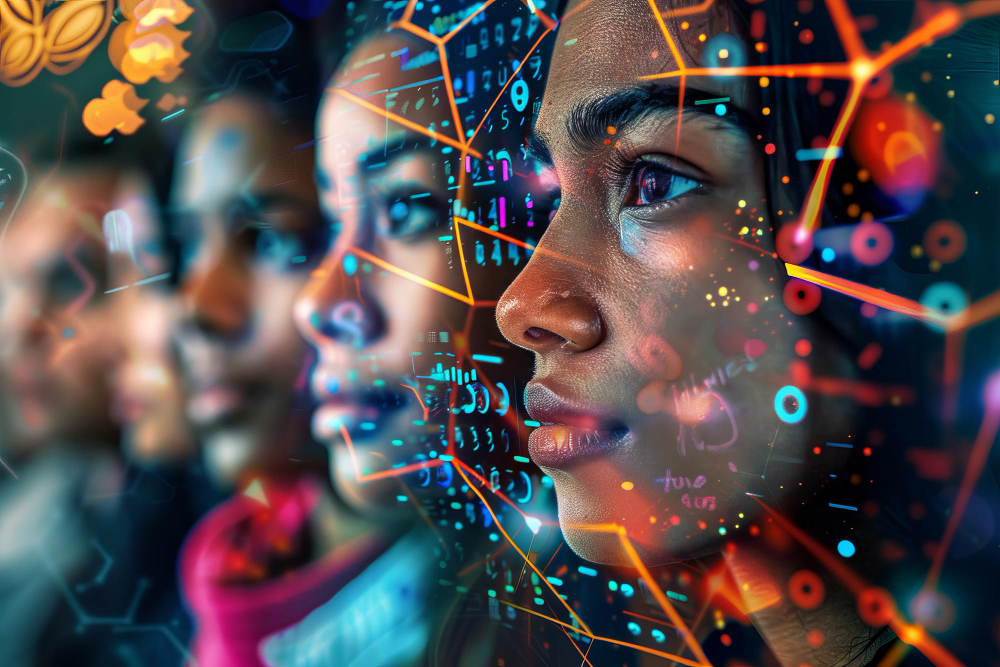Exploring Generative AI: Applications, Benefits, Challenges
Generative AI is a powerful technology that can create content like text, images, music, and more. It works by learning from large amounts of data and then using that knowledge to produce new content. For example, it can write articles, create artwork, or even compose music.
Understanding Generative AI is becoming increasingly important. This technology is changing how we work and live. It can help businesses become more efficient, save time, and spark new ideas. For individuals, it offers new ways to express creativity and solve problems. As it becomes more common, knowing how it works can help you make the most of its benefits and be aware of any potential drawbacks.
This blog aims to provide a simple guide to Generative AI. We will explore what it is, how it can be used, its benefits, and its challenges. By the end of this blog, you should have a clearer understanding of Generative AI and how it might impact your life or work.
Whether you are a business owner, a creative professional, or just curious about new technologies, this guide will help you understand Generative AI in an easy-to-understand way.
What is Generative AI?
Generative AI, also known as Generative Artificial Intelligence, is a revolutionary technology that enables the creation of new content across various mediums, including text, images, music, and videos. Unlike traditional programming, where machines follow specific instructions, Generative AI learns from vast amounts of data and uses that knowledge to generate original material.
How Generative AI Works
Generative AI operates by analyzing extensive datasets to discern patterns and structures. For instance, if trained on textual data, it learns the nuances of language, including sentence formation and idea cohesion. This enables it to generate text that closely resembles human writing.
Think of Generative AI as a skilled mimic. By observing numerous examples, such as paintings or musical compositions, it learns the stylistic elements and techniques employed. Subsequently, it can produce new content that mirrors the characteristics of the original, albeit entirely novel.
Examples of Generative AI Technologies
- GPT-4: This advanced tool is proficient in writing articles, answering queries, and engaging in conversations that mimic human speech patterns. They are widely used in chatbots, virtual assistants, and content-creation platforms.
- GANs (Generative Adversarial Networks): These networks excel in generating realistic images, videos, and animations. For instance, GANs can fabricate lifelike portraits of nonexistent individuals, craft artwork, or even conceptualize new product designs.
Generative AI streamlines tasks that traditionally necessitate extensive human input, thereby saving time and resources. Its applications span diverse domains, including entertainment, art, business, and healthcare. From crafting marketing content to fostering creativity in the arts, Generative AI is revolutionizing industries worldwide.
Understanding Generative AI’s capabilities is essential for harnessing its potential while navigating its challenges. Although it opens doors to exciting opportunities, ensuring the accuracy and fairness of generated content remains a critical consideration.
Applications of Generative AI
Generative AI, a cutting-edge technology, is revolutionizing various industries by automating tasks, enhancing creativity, and providing innovative solutions. Let’s explore how Generative AI is applied across different domains:
Content Creation
- Automated Writing and Storytelling: Generative AI proficiently crafts articles, stories, and even books. It aids journalists in swiftly drafting news pieces and assists authors by suggesting plot ideas and composing entire chapters, thereby saving time and ensuring high-quality content.
- Art and Design Generation: Artists and designers leverage Generative AI to generate unique artworks, graphics, and designs. By learning from existing works and exploring new ideas, it produces paintings, logos, and fashion designs, facilitating artistic exploration and streamlining repetitive tasks.
Marketing and Advertising
- Personalized Ad Creation: Generative AI tailors advertisements to individual preferences by analyzing customer data. Designing personalized ads that resonate with consumers, increases engagement and encourages product purchases.
- Customer Engagement Tools: Businesses deploy Generative AI-powered chatbots and virtual assistants to interact with customers, providing round-the-clock support and enhancing satisfaction and engagement levels.
Healthcare
- Drug Discovery: In healthcare, Generative AI accelerates drug discovery by analyzing existing medications and proposing new compounds for disease treatment. This expedites research efforts and aids in finding potential cures.
- Medical Imaging Analysis: Generative AI enhances medical imaging analysis by accurately interpreting X-rays, MRIs, and CT scans. It assists doctors in diagnosing illnesses more precisely and enables better decision-making for patient care.
Gaming and Entertainment
- Procedural Content Generation: Generative AI automates the creation of game levels, maps, and environments in gaming. This empowers developers to design intricate games without manual intervention, providing players with unique and immersive experiences.
- Virtual Characters and Environments: Generative AI generates lifelike virtual characters and environments, enriching gaming and virtual reality experiences. By creating dynamic content and immersive settings, it captivates players and enhances overall enjoyment.
Generative AI’s multifaceted applications demonstrate its potential to revolutionize industries, saving time, reducing costs, and improving product and service quality. As technology advances further, Generative AI will continue to offer innovative solutions, making everyday tasks more efficient and our lives more exciting. Understanding these applications underscores the transformative impact of Generative AI across diverse sectors.
Benefits of Generative AI
Generative AI offers numerous advantages across different domains, enhancing creativity, productivity, and cost-effectiveness. Here’s a closer look at its key benefits:
Enhanced Creativity and Innovation
Generative AI stimulates creativity by suggesting new ideas and producing original content. It assists artists in crafting unique designs and artworks, while writers can rely on it for fresh story ideas and text sections. In business, Generative AI fuels innovation by analyzing data and forecasting trends, facilitating the development of innovative products and solutions.
Efficiency and Productivity Improvements
Generative AI streamlines workflows by automating repetitive tasks, allowing individuals to focus on more critical activities. For instance, in marketing, it swiftly generates personalized advertisements, saving time for marketers. In healthcare, it expedites medical image analysis, aiding doctors in prompt diagnosis. This heightened efficiency boosts overall productivity, enabling individuals to accomplish more in less time.
Cost Reduction in Various Industries
By optimizing processes and reducing manual labor, Generative AI contributes to cost savings across industries. It minimizes operational expenses for businesses and enhances production efficiency in manufacturing, leading to reduced waste and increased profitability. Moreover, it enables the creation of cost-effective marketing strategies, ensuring better returns on investment through targeted advertising.
Personalization and Improved User Experiences
Generative AI enables personalized interactions, enhancing user experiences across various services. Online retailers leverage it to recommend products based on individual preferences, facilitating a seamless shopping experience. In entertainment, it customizes content, such as tailored video recommendations and immersive gaming experiences, fostering higher customer satisfaction and engagement.
Generative AI’s ability to foster creativity, streamline operations, reduce costs, and deliver personalized experiences renders it indispensable across diverse sectors. Its benefits empower individuals and businesses alike, enabling them to achieve their objectives more efficiently and effectively.
Challenges of Generative AI
While AI offers numerous benefits, it also poses several challenges that necessitate attention and careful management. Understanding and addressing these challenges is crucial for responsible and effective utilization of the technology.
Ethical Considerations
Generative AI’s ability to produce highly realistic content raises ethical concerns, particularly regarding the creation of deepfakes—fake images and videos with deceptive realism. These can perpetuate misinformation and deceive individuals, underscoring the importance of ethical reflection and oversight.
Bias and Fairness
Generative AI learns from data, making it susceptible to biases inherent in the training data. This can result in unfair treatment and discrimination, highlighting the need for diverse and representative datasets to mitigate bias and ensure equitable outcomes.
Deepfakes and Misinformation
The proliferation of deepfakes poses significant challenges, including the dissemination of false information and the manipulation of public opinion. Detecting and combating the misuse of deepfakes requires the development of robust detection mechanisms and preventive strategies.
Technical Challenges
Generative AI encounters technical hurdles, such as the acquisition of sufficient and high-quality data. Inadequate data quality or quantity can compromise the accuracy and reliability of AI-generated outputs, emphasizing the importance of data integrity and comprehensive datasets.
Data Quality and Quantity
Effective performance of Generative AI relies on access to extensive and high-quality datasets, which can be challenging and resource-intensive to procure. Ensuring the cleanliness, diversity, and adequacy of data remains a significant challenge in AI development.
Computational Requirements
Generative AI demands substantial computational resources to process data and generate content, leading to cost and energy considerations. Balancing computational needs with environmental and financial sustainability is imperative for responsible AI deployment.
Regulatory and Legal Issues
Navigating the complex landscape of AI regulations and laws presents a considerable challenge. Compliance with evolving regulations regarding data privacy, intellectual property, and ethical AI use requires ongoing diligence and legal expertise.
Intellectual Property Concerns
Generative AI’s capacity to create new content raises questions about intellectual property rights and ownership. Determining ownership and rights for AI-generated content presents legal complexities that necessitate clear guidelines and legal frameworks.
Compliance with Laws and Regulations
Ensuring compliance with relevant laws and regulations is paramount for responsible AI implementation. Adhering to data privacy laws, intellectual property rights, and ethical AI guidelines requires continuous monitoring and adherence to evolving regulatory standards.
In conclusion, while Generative AI holds immense potential, addressing its associated challenges is essential for realizing its benefits responsibly. Ethical considerations, bias mitigation, combating misinformation, technical hurdles, data integrity, computational demands, regulatory compliance, intellectual property rights, and legal adherence all warrant careful attention. By proactively addressing these challenges, we can harness the transformative power of Generative AI while minimizing associated risks.
Future of Generative AI
Generative AI is poised for rapid evolution, promising a plethora of exciting advancements and breakthroughs in the years to come. Let’s explore what lies ahead:
Potential Advancements and Breakthroughs
In the foreseeable future, Generative AI will ascend to new heights of potency and efficiency. Anticipate even more lifelike images, videos, and sounds generated with remarkable realism. With the ability to produce complex content using less data and fewer resources, Generative AI will deliver faster and more precise results, emerging as an indispensable asset across diverse industries.
Emerging Trends and Research Areas
- Improved Personalization: Generative AI will continue refining its ability to personalize content for individuals, offering tailored ads, enhanced movie or product recommendations, and immersive customer experiences.
- Creative Collaborations: Expect collaborations between artists, musicians, and writers leveraging Generative AI to create innovative works that meld human creativity with AI capabilities, unlocking new realms of artistic expression.
- Healthcare Innovations: In healthcare, Generative AI will revolutionize personalized treatment plans, drug discovery, and diagnostic tools, ultimately improving patient outcomes and enhancing healthcare efficiency.
Long-term Impact on Various Industries
- Entertainment: The entertainment sector will witness a surge in AI-generated movies, music, and video games, captivating audiences with unique experiences previously unattainable.
- Business and Marketing: Businesses will harness Generative AI to craft personalized marketing campaigns, innovate product development, and elevate customer service standards, fostering operational efficiency and elevating customer satisfaction.
- Education: Generative AI will reshape education by creating personalized learning materials, aiding teachers in lesson planning, and offering tailored tutoring to students, fostering more effective and engaging learning experiences.
Generative AI is poised to redefine our lives and work, empowering us to achieve greater feats, unleash boundless creativity, and tackle complex challenges with innovative solutions. Understanding the potential advancements, emerging trends, and long-term impacts of Generative AI equips us to embrace and leverage the transformative changes it heralds.
Conclusion
Staying informed about Generative AI is paramount, given its transformative impact on our work and daily lives. This technology has the potential to enhance our creativity, efficiency, and productivity significantly. Understanding Generative AI empowers us to harness its capabilities responsibly and leverage its benefits effectively.
Explore and delve deeper into Generative AI to uncover its myriad applications and possibilities for personal and professional growth. Whether you’re intrigued by its potential applications or considering its integration into your business operations, acquiring insights into Generative AI will position you at the forefront of a rapidly evolving landscape.




